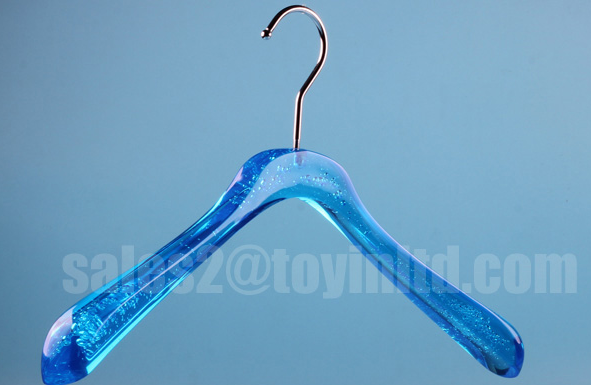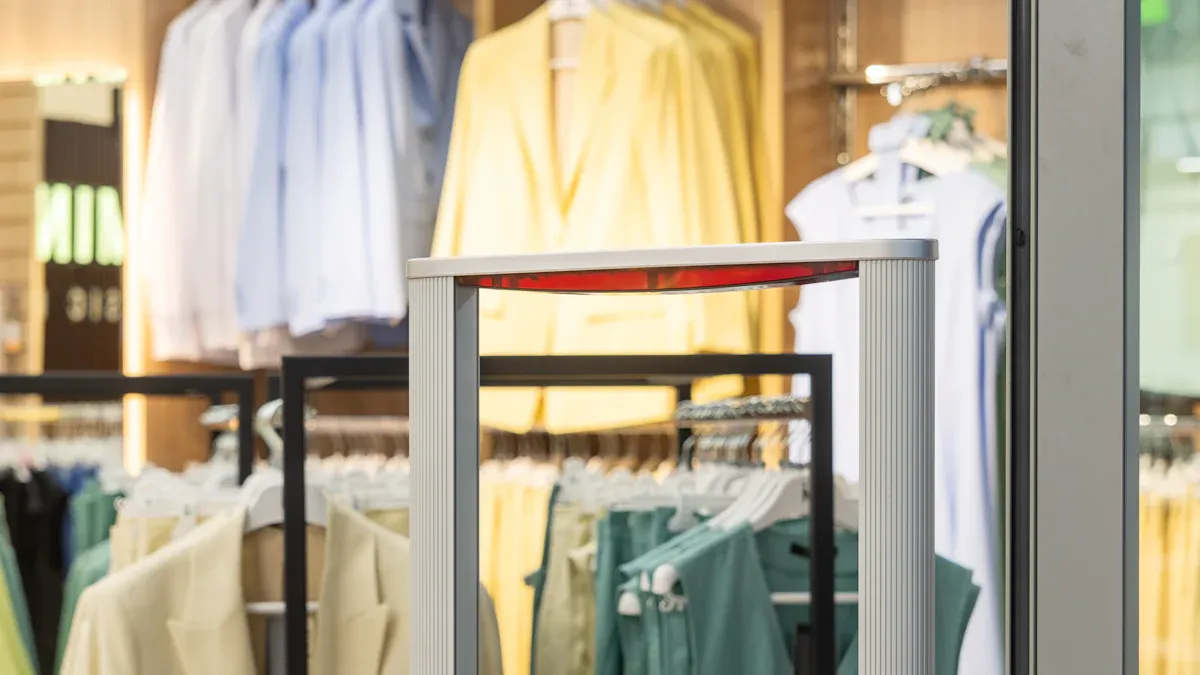Focus on Quality and Durability: Your slatwall, slatwall panels, slatwall hooks, and even the slatwall installation demand attention. The quality and durability of your slatwall is a key defense. Weak slatwall is a point of failure for retail theft and breakage.
Matching Materials to High-Risk Zones

You must match your materials to the risks in each zone of your business. The right safe display materials protect your inventory differently in a showroom versus a warehouse. A smart merchandising strategy begins with analyzing these high-risk areas.
Showroom Floor Displays
Your showroom floor is a high-traffic retail environment. You face constant risks from shopping carts, frequent cleaning, and general store wear and tear. Weak fixtures lead to breakage and create opportunities for retail theft. Your slatwall is a primary defense. Using low-quality slatwall panels can result in failure. You need secure retail displays built for durability. Even small components like locks and keys can fail, so the overall quality of your slatwall and slatwall panels is critical. A strong slatwall system not only holds products but also deters retail theft. The quality of your slatwall installation directly impacts its strength.
Warehouse and Staging Areas
Your warehouse presents different dangers. The main risks here are structural failures and falling objects. A pallet rack collapse can destroy thousands of dollars in stock instantly. You must use materials designed for heavy-duty applications.
Safety Tip: For your main storage racks, choose structural steel to prevent collapse under heavy loads. Your slatwall used in staging must also have high load capacity.
Poorly stacked items on weak slatwall panels create a serious hazard. Proper slatwall and shelving prevent these accidents. This focus on durability protects both your inventory and your staff in a busy retail environment. A weak slatwall is a liability you cannot afford.
Countertop and POP Displays
Countertop displays must grab attention and withstand interaction. Common failures include using low-quality acrylic that yellows or cracks, weak welds on metal stands, and poor hardware. These issues make your products look cheap and increase the chance of retail theft. Your customized displays need to be sturdy.
Material Choice: Use durable aluminum frames and high-quality acrylic for a lightweight yet strong display.
Security: Good design is essential for preventing shoplifting. Some secure retail displays can even incorporate anti-theft devices.
Your slatwall panels and slatwall hooks at the point of purchase must also be robust. A flimsy slatwall display will quickly fail, costing you sales and stock.
Comparing Safe Display Materials
You must choose the right material for each specific need. Your selection of safe display materials directly impacts stock safety and fixture longevity. Understanding the strengths and weaknesses of each option helps you make an informed investment.
Polycarbonate: The Unbreakable Choice
You should choose polycarbonate for maximum security and impact resistance. This material is virtually unbreakable, making it ideal for protecting high-value merchandise. Its strength provides peace of mind in high-traffic or high-risk areas. Consider its impact resistance compared to other clear materials:
Material | Impact Resistance (compared to glass) |
|---|---|
Polycarbonate | |
Acrylic | |
Glass | Standard (baseline) |
High-security environments rely on polycarbonate for this very reason. You see it used in:
Banks for bullet-resistant teller windows.
Jewelry Stores for
shatterproof display casesthat deter smash-and-grab theft.Government Buildings for securing sensitive areas.
When you need to guarantee product safety on a slatwall display, polycarbonate accessories or protective shields offer unmatched protection.
Acrylic and PETG: Clarity and Versatility
You can use acrylic and PETG for displays that require excellent visual clarity. These modern plastics offer a clean, high-end look without the weight or safety risk of standard glass. Acrylic provides superior optical quality, while PETG offers better impact resistance.
Property | Acrylic | PETG |
|---|---|---|
Optical Clarity | Excellent (92% light transmission) | Very Good |
Scratch Resistance | Better | Moderate (scratches more easily) |
Impact Resistance | Prone to cracking | |
Cost | Tends to be more expensive |
Choose acrylic for beautiful countertop units or signage where appearance is key. You can select PETG for custom fixtures that may endure more bumps and handling. Both materials are excellent for creating custom holders and shelves for your slatwall system, enhancing the presentation of your slatwall panels. The quality of your slatwall display is elevated with these clear components. A good slatwall deserves high-quality accessories.
HDPE: The Warehouse Workhorse
You need materials built for tough environments in your warehouse and backstock areas. High-Density Polyethylene (HDPE) is the perfect choice for these heavy-duty applications. It is a durable plastic that resists chemicals, moisture, and impacts from machinery or dropped items. Its non-porous surface is also hygienic and easy to clean. You can use it for:
Protective wall linings and corner guards.
Durable, long-lasting pallets and storage bins.
Workbenches and surfaces that resist dents and scratches.
moisture-resistant panelsin damp storage zones.
While metal offers a higher load capacity, reinforced HDPE provides a cost-effective and resilient alternative for many shelving needs. It is an essential material for protecting your inventory and infrastructure behind the scenes, supporting your main slatwall and racking systems. The quality of your backroom operations improves with HDPE.
Tempered Glass and Metal
You can still use traditional materials like tempered glass and metal effectively. Tempered glass is much safer than standard annealed glass. It shatters into small, dull pieces upon breaking, reducing injury risk. However, it breaks completely under sharp force, making it a poor choice for preventing theft. Use it for enclosed cabinets or upper shelving where direct impact is less likely.
Metal offers exceptional strength and durability. Powder-coated steel and aluminum are excellent choices for fixture frames, legs, and heavy-duty hardware.
Pro Tip: Powder coating provides a durable, corrosion-resistant finish that extends the life of your fixtures and enhances their appearance. It protects steel from rust and aluminum from oxidation.
Your slatwall system relies on the strength of metal. High-quality metal inserts for slatwall panels and robust steel slatwall hooks are critical for holding heavy merchandise securely. Never compromise on the metal components of your slatwall.
Wood and Industrial-Grade MDF
You can use wood and MDF to create a warm, inviting atmosphere. Solid wood offers a classic look and great durability, but it comes at a higher cost. For a balance of performance and value, industrial-grade Medium-Density Fiberboard (MDF) is a superior choice for many fixtures, including slatwall.
Feature | Solid Wood | Plywood | Industrial-Grade MDF |
|---|---|---|---|
Strength | Very Strong | Strong | Good, consistent strength |
Surface | Natural Grain | Wood Grain | Smooth, ideal for paint |
Cost | High | Moderate | Low |
Moisture | Can be resistant | Susceptible to damage | Swells if not sealed |
When choosing MDF for slatwall panels, you must insist on E1-grade or higher. This standard ensures low formaldehyde emissions for safety and a dense core for superior screw-holding strength. Using standard, low-density MDF for your slatwall is a common point of failure. Heavy-duty 25mm or 30mm thick E1-grade slatwall panels provide the rigidity needed to prevent bowing and ensure your slatwall can handle its intended weight. The structural integrity of your slatwall panels depends entirely on this choice.
Optimizing Slatwall for Durability

Your slatwall is a versatile fixture, but it can be a major point of failure. You risk stock loss and safety hazards if you choose the wrong material. A strong slatwall system begins with selecting the right slatwall panels for your environment. The quality of your slatwall is an investment.
Choosing Durable Slatwall Panels
You must choose slatwall panels that can handle your store's conditions. The main options offer different benefits.
PVC Slatwall: This material is a great choice for durability. It resists moisture and is easy to clean. PVC slatwall panels are lightweight but can support heavy loads.
Metal Slatwall: You should use metal for your heaviest items. These slatwall panels are extremely strong. Wire slatwall systems made from steel offer great strength and a simple look.
MDF Slatwall: This is an affordable option for controlled climates. However, these slatwall panels can warp in humid areas.
The quality of your slatwall panels directly impacts safety and longevity.
MDF vs. PVC Slatwall
You need to understand the key differences between MDF and PVC slatwall. PVC slatwall panels are highly durable and resistant to moisture, making them ideal for garages or damp areas. MDF slatwall panels are less expensive but have poor moisture resistance. MDF absorbs water and swells, which compromises its structure. This makes it a poor choice for any area with changing humidity. While you can paint MDF slatwall panels for a custom look, PVC offers a more modern finish and requires less maintenance. The superior quality of PVC makes it a better long-term choice for a busy retail slatwall.
Reinforcement and Weight Capacity
You can increase the strength of your slatwall. The load capacity of slatwall panels often depends on their thickness. A standard 0.75-inch thick panel might hold 25-50 pounds per bracket. Thicker slatwall panels can hold more. For maximum strength, you should use metal inserts.
Pro Tip: High-grade aluminum inserts are the best way to reinforce your slatwall panels. They slide into the grooves and dramatically increase the load-bearing capacity of your slatwall.
These inserts fortify the slatwall, creating a superior display system. Always verify the safety certifications and weight limits for your slatwall system to ensure proper durability.
Checklist for Implementation and Safety
You can protect your inventory and profits with a clear safety plan. This involves checking your current fixtures, building new ones correctly, and handling materials with care. A good plan reduces breakage and opportunities for retail theft.
Auditing Your Current Fixtures
You should regularly check your fixtures for signs of wear. A consistent audit helps you find problems before they cause stock loss or create safety hazards in your retail environment. Look for warning signs that indicate your fixtures are failing. The quality of your slatwall and other displays is key.
Warning Sign | Potential Issue | Why You Must Inspect |
|---|---|---|
Beam sagging or deflection | Overloading or material fatigue | Risk of collapse under load |
Bent or dented uprights | Impact damage | Load capacity is compromised |
Rust or missing safety locks | Corrosion or missing parts | Connections are weakened |
Catching these issues early prevents costly accidents. A weak slatwall is a liability that can lead to retail theft. Regular checks on your slatwall system are essential.
Building Secure Retail Displays
You must build your displays to be stable and secure. Proper assembly is your first line of defense against tipping and collapse. This is especially important for tall or heavy units.
Anchor It: You should secure tall shelving to a solid wall surface like studs or concrete. This prevents forward tipping. Using both wall and floor anchors provides maximum stability for your slatwall.
Balance the Weight: Place heavier items on the lower shelves of your slatwall. This creates a lower center of gravity and makes the display more stable.
Use Security Features: Building secure retail displays is essential for preventing shoplifting. You can integrate anti-theft devices directly into your displays. This strategy helps deter retail theft.
These steps create a safer retail environment and are vital for preventing shoplifting. Your slatwall should be a secure asset.
Best Practices for Transport and Handling
You need to handle your display components carefully to maintain their quality. The durability of your fixtures starts with safe transport.
Pro Tip: Always keep the protective film on acrylic or plastic parts until final assembly. This simple step prevents scratches during handling and installation of your slatwall components.
When moving large pieces, use proper padding like foam or bubble wrap. This protects your investment in safe display materials. Good handling ensures your custom fixture programs result in flawless, secure retail displays. Your slatwall and its accessories deserve careful treatment. The quality of your slatwall installation depends on it. You can also use anti-theft devices on your slatwall.
You must have a proactive strategy for safe display materials. This is a direct investment in your business. The right choices reduce replacement costs and stop retail theft. High-quality materials create a safer retail environment and deter retail theft. Your slatwall quality is critical for preventing shoplifting. A strong slatwall has durability. A weak slatwall invites retail theft. Your slatwall is part of your secure retail displays. A quality slatwall is key in a busy retail environment. This slatwall, slatwall, slatwall, and slatwall all build secure retail displays that stop retail theft.
Audit your fixtures and upgrade your materials today to secure your inventory and protect your profits.
FAQ
What is the most durable material for slatwall?
You should choose PVC or metal options for maximum durability. PVC slatwall resists moisture and is very strong. Metal offers the highest load capacity. Both materials protect your investment far better than standard MDF.
How can I make my current slatwall stronger?
You can reinforce your display with metal inserts. These inserts slide directly into the grooves. They dramatically increase the weight your slatwall can hold. This is the best way to improve an existing system's strength.
What if I have unique display needs for my slatwall?
You can use custom fixture programs for special requirements. These programs help you design unique holders for your slatwall. This ensures your display perfectly matches your products, creating an effective slatwall presentation.
Why is my MDF slatwall warping?
Your MDF display likely absorbed moisture from the air. Standard MDF swells and weakens in humid areas, causing it to fail. You should use PVC slatwall in any space with moisture. This type of slatwall will not warp.

